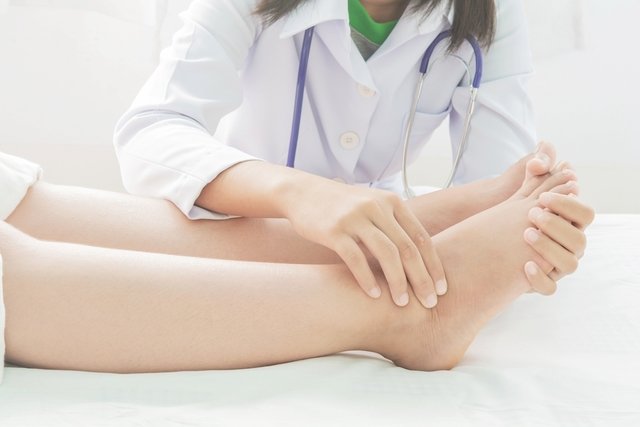Fluid retention is the abnormal accumulation of fluids in the body, causing swelling in one or more parts of the body, most frequently occurring on the legs, feet, ankles, face, belly, arms, hands and back, for example, but it can also happen in different locations at the same time or all over the body.
Fluid retention is usually caused by hormonal changes in PMS or pregnancy, excessive salt consumption, standing still for a long time in the same position or lack of regular physical activity, but it can also occur due to some diseases, such as diabetes, high blood pressure or liver or kidney failure.
Fluid retention can be relieved with simple measures such as elevating the legs, or raising the arms by opening and closing the hands, for example. However, if there is sudden swelling of the legs, feet or hands, redness in the area, shortness of breath or chest pain, you should go to the nearest emergency room immediately so that the cause can be identified and the most appropriate treatment can be indicated. .

Fluid retention symptoms
The main symptoms of fluid retention are:
- Swelling in the face, belly, legs, ankles, feet, arms, hands or back;
- Tight and shiny skin in the affected area;
- Pain or increased sensitivity at the site;
- Stiffness in the affected joint;
- Increase in body weight;
- Decrease in the amount of urine produced and released per day.
One way to know that it is fluid retention is to press on the area that is swollen for about 30 seconds. If the area is marked, it indicates that there is an accumulation of fluids in the area.
Although swelling is more common in one or more parts of the body, generalized swelling can also occur, that is, throughout the body, and this condition is known as anasarca. Understand what anasarca is and know how to identify the symptoms.
In the presence of symptoms of fluid retention, you should consult a cardiologist or general practitioner to identify the cause and initiate the most appropriate treatment.
Make an appointment with a cardiologist in the nearest region:
Taking care of your health has never been easier!
Possible causes
The main causes of fluid retention are:
1. Food rich in salt
A diet rich in salt can cause fluid retention in the body and this occurs because salt contains a lot of sodium that retains water and, therefore, if it is present in large quantities in the body, it increases fluid retention.
What to do: A good option to avoid fluid retention is to use low-sodium salt or use aromatic herbs to reduce salt consumption or avoid adding salt to meals.
2. Pregnancy
Fluid retention during pregnancy is an expected change and considered normal, as during pregnancy there is an increase in the production of the hormone relaxin, which causes blood vessels to dilate and leads to swelling in the legs and ankles, mainly.
This happens because when the blood reaches the legs it cannot return to the heart as easily, stimulating the accumulation of fluids in the space between the cells, which causes swelling.
What to do: drink at least 8 glasses of water during the day, elevate your legs whenever possible, reduce salt consumption or do light physical activities such as walking or water aerobics, for example, as long as approved by the obstetrician, to improve blood circulation and increase elimination of liquids. See other ways to alleviate fluid retention during pregnancy.
3. Not drinking water during the day
Keeping the body hydrated is essential for maintaining cell functions and kidney function, helping to eliminate excess sodium from the body, and therefore, not drinking water is one of the reasons for fluid retention.
Additionally, dehydration causes the body to retain more water to compensate for the lack of water, which leads to fluid retention and bloating.
What to do: consume at least 1.5 to 3 liters of water per day in its natural form, sparkling, flavored or in unsweetened teas.
Watch the video with nutritionist Tatiana Zanin with tips on how to increase water consumption to help reduce fluid retention:
4. Lack of physical activity
Lack of physical activity influences blood circulation, which becomes slower, which can cause fluid retention in the body, especially in the legs, ankles and feet.
What to do: Regular physical activity helps prevent and improve fluid retention by improving blood circulation, making blood circulate more efficiently in the body. Therefore, you must do physical activities, at least 30 minutes, 5 times a week, such as light walking, swimming or water aerobics, for example.
5. Remaining still in the same position for a long time
Staying for long periods of time standing or sitting, such as at work or on long trips, for example, can be a cause of fluid retention, as remaining still for a long time in the same position makes it difficult for blood to return from the legs or arms to the body. heart and can cause swelling of the legs, feet, ankles, hands or arms.
What to do: If you sit for a long time, you should move your feet up and down every hour or walk every 5 minutes, and raise your arms, opening and closing your hands to stimulate blood circulation, for example. If you are standing for a long time, you should bend your legs and ankles, make circular movements with your feet and raise your arms by opening and closing your hands. These measures can help prevent fluid retention. You can also do massage or lymphatic drainage to activate circulation. Find out how to do lymphatic drainage at home.
6. Use of medications
The use of some medications can cause fluid retention and swelling in the hands and feet, such as corticosteroids, minoxidil, or medications to treat high blood pressure such as captopril, enalapril, lisinopril, amlodipine, nimodipine, for example.
What to do: You should follow up with the doctor who prescribed one of these medications to assess the dose or whether it is necessary to change the treatment, for example. However, simple measures can be done at home, such as elevating the legs, raising the arms, massage or lymphatic drainage or light walking to improve blood circulation and relieve fluid retention.
7. Hormonal changes in the menstrual cycle
Fluid retention is very common in women due to hormonal changes during the menstrual cycle, especially during PMS, and is noticed through abdominal or breast swelling.
Additionally, menopause can also cause fluid retention.
What to do: You should consult a gynecologist to carry out an assessment of female hormones such as estrogen and progesterone, to begin the most appropriate treatment that can be done with the use of contraceptives or hormone replacement therapy, for example, recommended by the doctor.
8. Thyroid diseases
Some hormonal diseases can also cause fluid retention, such as hypothyroidism, due to variations in the amount of hormones T3 and T4, which are important for maintaining fluid levels in the body, which can cause swelling in the abdomen, legs, arms or face, for example. example.
What to do: an endocrinologist should be consulted to evaluate thyroid hormones, and thus the most appropriate treatment for hypothyroidism can be indicated, which is normally done with the use of levothyroxine. See how hypothyroidism is treated.
9. Cardiovascular problems
Fluid retention can occur due to heart problems such as high blood pressure, heart failure or venous insufficiency, due to difficulty in pumping blood from the heart, or because the vein valves do not work properly.
This makes it difficult for blood to return to the heart, which can lead to fluid accumulation and cause swelling in the legs, feet, hands, arms or abdomen, for example.
What to do: You should consult a cardiologist or angiologist to assess the cause of fluid retention and begin treatment, which can be done with antihypertensive medications or diuretics, in the case of high blood pressure or heart failure. In the case of venous insufficiency, the doctor may recommend the use of compression stockings or even surgery. Check out the main remedies for fluid retention.
In addition, it is recommended to do light physical activities approved by your doctor, such as walking, and moving your legs and arms during the day, lying down and elevating your legs above heart level before sleeping for 20 minutes.
10. Kidney failure
Kidney failure is a condition in which the kidneys do not function properly and therefore do not eliminate fluid from the body through urine, which can lead to fluid retention and swelling of the feet, hands and face.
What to do: Kidney failure must be monitored by a nephrologist so that the most appropriate treatment can be given. In some cases where kidney failure is at a more advanced stage, it may be necessary to undergo hemodialysis, prescribed by the doctor. See all treatment options for kidney failure.
11. Liver failure
Liver failure is a decrease in liver function and can cause fluid retention mainly in the hands, feet and abdomen, due to a decrease in a protein in the blood, albumin, which helps keep the blood inside the vessels.
This disease can be caused by alcoholism, hepatitis or even the use of medication such as paracetamol.
What to do: liver failure must be treated by a hepatologist. In addition, you should stop drinking alcohol and reduce the consumption of salt and proteins in your diet to avoid swelling of your hands and feet, and the accumulation of fluid in the abdomen. Find out how liver failure is treated.
When to go to the doctor
Some symptoms may accompany fluid retention and require medical attention as soon as possible and include:
- Shortness of breathe;
- Cough or expectoration;
- Chest pain or headache;
- Pain below the ribs;
- Persistent pain or swelling in the legs;
- Sudden swelling;
- Tight or shiny skin;
- Swelling in only one foot or one hand;
- Redness of the swollen region;
- Fever;
- Tingling in the feet, legs, arms or hands.
In addition, you should seek medical help immediately or the nearest emergency room if you experience pain or swelling in your legs after traveling by plane or sitting for a long time, as this could be a symptom of thrombosis. Know how to identify all the symptoms of thrombosis.

Sign up for our newsletter and stay up to date with exclusive news
that can transform your routine!
Warning: Undefined array key "title" in /home/storelat/public_html/wp-content/plugins/link-whisper-premium/templates/frontend/related-posts.php on line 12
Warning: Undefined array key "title_tag" in /home/storelat/public_html/wp-content/plugins/link-whisper-premium/templates/frontend/related-posts.php on line 13



